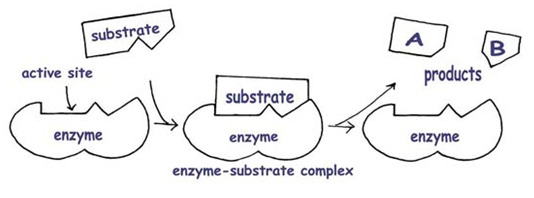Food Allergies vs. Intolerance
16th May 2017
Many people confuse food allergies with intolerance; the thought that they are the same is a common misconception. Intolerance can cause some of the same symptoms as a food allergy, but overall is less severe. As a reaction to a food intolerance, one might have digestive issues or even headaches, but a food allergy is an immune system response that can cause far more serious health issues, including anaphylaxis (closing of the throat).
One of the main causes of food intolerance is lacking the necessary enzyme to breakdown a specific molecule. For example, in milk, lactose is a type of sugar. Someone who is lactose intolerant does not possess the enzyme lactase that breaks down lactose.

In the picture above, the substrate is the lactose and the enzyme is the lactase. Each substrate-enzyme pair is unique and neither part can be substituted by something else. If the lactose molecule can’t find the right enzyme to attach to, it cannot be broken into its A and B parts, glucose and galactose, which make digestion easier.
So why can some people with lactose intolerance eat cheese and yogurt? This is because as these foods are processed, some of the lactose is broken down. The degree of intolerance varies from person to person, so while Person A might be able to eat yogurt, Person B might not.
Nearly any food can be the source of an intolerance, even a food additive. Sulfites, commonly found in items as diverse as ham and red wine, have been found to give some people migraines. Certainly, this is unpleasant, but it is still not as debilitating as an allergy can be.
Ninety percent of those with a food allergy are affected by one of the eight major allergens: wheat, egg, soy, milk, peanuts, tree nuts, fish, and shellfish. Food allergies differ from intolerances in that a person’s immune system reacts to a food by attacking it because it mistakenly interprets it as something that is harmful to the body. The body releases antibodies called immunoglobulin E (IgE) to fight off the “bad” food. The IgE in turn sends a signal to release a chemical called histamine. If that word sounds familiar, it’s because anti-histamines are the main ingredient in Benadryl, a drug used to fight, you guessed it, allergies.
A surge in production of histamine can cause itching, dry throat, rashes or hives, lethargy, and even anaphylactic shock. Allergies can be much more severe than intolerances for this reason. Like intolerances, there are different degrees of allergies. A child’s peanut allergy, for example, may be so severe that if a classmate has a peanut butter sandwich on the other side of the lunchroom an hour previous, it could trigger anaphylaxis. Another child with a peanut allergy may be able to eat lunch right next to someone eating a PB&J. Both situations need to be handled with caution because allergies are potentially life-threatening. If you or someone you care for has an allergy or an intolerance, be sure to always check ingredient statements for the allergen before consuming.

